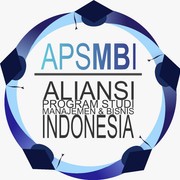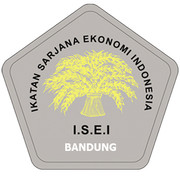KINERJA SISTEM INFORMASI YANG DIDUKUNG OLEH MANAJEMEN PUNCAK
Abstract
This study aimed to examine the effect of top management support and the ability of users of accounting information systems on the performance of accounting information systems using system user satisfaction measure. The methods used to collect research data is a survey method data obtained by distributing questionnaires to the respondents. Research data based on user perceptions of respondents accounting information system by 30 respondents from bank bjb Cabang Suci. In this study, the test data used method is validity, reliability testing, and classical assumption. Then multiple linear regression analysis was used to test the hypothesis. Results of multiple linear regression analysis showed that the support of top management and accounting capabilities of information systems users significant positive effect on the performance of accounting information systems either partially or simultaneously.
Keywords
Full Text:
PDFReferences
Ahuja, B.N. 1996. Dictionary of Management, Singapura: S.S. Mubaruk & Brothers Ltd.
Al-Adaileh, R.M. 2009. An evaluation of information systems success: A user perspective - the case of Jordan Telecom Group, European Journal of Scientific Research, Vol. 37 No. 2, hlm. 226-239.
Almilia, L.S. & Briliantien, I. 2007. Faktor-faktor yang Mempengaruhi Kinerja Sistem Informasi Akuntansi pada Bank Umum Pemerintah di
Wilayah Surabaya dan Sidoarjo, (Online)(http://spicaalmilia.wordpress.com, diakses pada tanggal 5 Februari 2013).
Anderson, E.E. 1985. Managerial considerations in paricipative design of MIS/DSS, Information and Management, Vol. 9 No. 4, hlm. 201-207.
Bailey, J. E., & Pearson, S. W. 1983. Development of a tool for measuring and analyzing computer user satisfaction, Management Science, Vol. 29 No. 5, hlm. 530-545.
Benbasat, I., Dexter, A.S., & Mantha, R.W. 1980. Impact of organizational maturity on information system skill needs, MIS Quarterly, Vol. 4 No. 1, hlm. 21-34.
Choe, J.M. 1996. The relationships among performance of accounting information systems, influence factors, and evolution level of information systems, Journal of Management Information System / Spring, Vol. 12 No. 4, hlm. 215-239.
DeLone, W.H., 1988. Determinants of success for computer usage in small business, MIS Quarterly, Vol. 12 No. 1, hlm. 51-61.
Doll, W.J. 1985. Avenues for top management involvement in successful MIS development, MIS Quarterly, Vol. 9 No. 1, hlm. 17-35.
Doll, W.J. & Torkzadeh, G. 1988. The management of end-user computing satisfaction, MIS Quarterly, Vol. 12 No. 2, hlm. 259-274.
Edstrom, A. 1977. User influence and the success of MIS projects: A contingency approach, Human Relations, Vol. 30 No. 7, hlm. 589-607.
Fung Jen, T. 2002. Faktor-faktor yang mempengaruhi kinerja sistem informasi akuntansi, Jurnal Bisnis dan Akuntansi, Vol. 4 No. 2.
Henderson, J.C. & Treacy, M.E. 1986. Managing end-user computing for competitive advantage, Sloan Management Review, Vol. 27 No. 4, hlm. 25-34.
Hirschheim, R.A. 1985. User experience with and assessment of participative systems design, MIS Quarterly, Vol. 9 No. 4, hlm. 295-309.
Ives, B., Hamilton, S., & Davis, G.B. 1980. A framework for research in computer based management information systems, Management Science, Vol. 26 No. 9, hlm. 910-934.
Ives, B., Olson, M.H., & Baroudi, J.J. 1983. The measurement of user information satisfaction, Communications of the ACM, Vol. 26 No. 10, hlm. 785-793.
Keen, P.G.W. 1981. Information system and organizational change, Communications of The ACM, Vol. 24 No. 1, hlm. 24-33.
Kim, E.H. & Lee, J.J. 1986. An exploratory contingency model of user participation and MIS use, Information and Management, Vol. 11 No. 2, hlm. 87-97.
Komara, A. 2006. Analisis faktor-faktor yang mempengaruhi kinerja sistem informasi akuntansi, Jurnal Maksi, Vol. 6 No. 2, hlm. 143-160.
Montazemi, A.R. 1988. Factors affecting information satisfaction in the context of the small business environment, MIS Quarterly, Vol. 12 No. 2, hlm. 239-256.
Raghunathan, B. & Raghunathan, T.S. 1988. Impact of top management support on information system planning, Journal of Information Systems / Spring, hlm. 15-23.
Robbins, S.P. 2005. Organizational Behavior: Concepts, Controversies, and Applications, ed.9, Englewood Cliffs NJ: Prentice-Hall.
Rockart, J.F. 1979. Chief executives define their own data needs, Harvard Business Review, Vol. 57 No. 2, hlm. 81-93.
Soegiharto. 2001. Influence factors affecting the performance of accounting information systems, Gajah Mada International Journal of Business, Vol. 3 No. 2, hlm. 177-202.
Tait, P. & Vessey, I. 1988. The effect of user involvement on system success: A contingency approach, MIS Quarterly, hlm. 91-108.
Wan, T.B. & Wah, L.T. 1990. Validation of a user satisfaction instrument for office automation success, Information and Management, Vol. 18 No.
, hlm. 203- 208.
DOI: https://doi.org/10.17509/image.v4i1.2328
Refbacks
- There are currently no refbacks.
Copyright (c) 2016 Adib Sultan
Image : Jurnal Riset Manajemen is licensed under a Creative Commons Attribution-ShareAlike 4.0 International License
View My Stats



